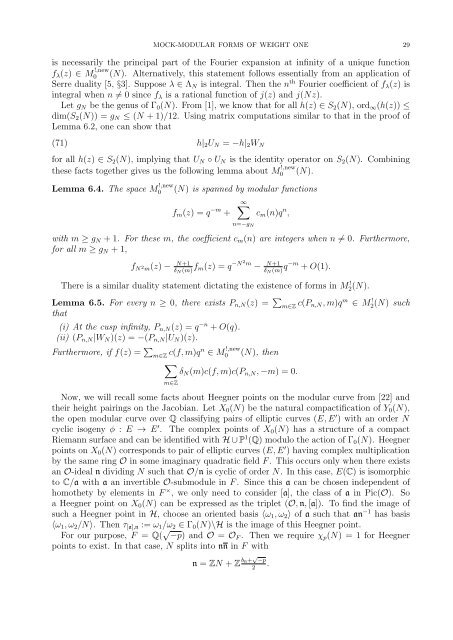Mock-modular forms of weight one - UCLA Department of Mathematics
Mock-modular forms of weight one - UCLA Department of Mathematics
Mock-modular forms of weight one - UCLA Department of Mathematics
You also want an ePaper? Increase the reach of your titles
YUMPU automatically turns print PDFs into web optimized ePapers that Google loves.
MOCK-MODULAR FORMS OF WEIGHT ONE 29<br />
is necessarily the principal part <strong>of</strong> the Fourier expansion at infinity <strong>of</strong> a unique function<br />
f λ (z) ∈ M !,new<br />
0 (N). Alternatively, this statement follows essentially from an application <strong>of</strong><br />
Serre duality [5, §3]. Suppose λ ∈ Λ N is integral. Then the n th Fourier coefficient <strong>of</strong> f λ (z) is<br />
integral when n ≠ 0 since f λ is a rational function <strong>of</strong> j(z) and j(Nz).<br />
Let g N be the genus <strong>of</strong> Γ 0 (N). From [1], we know that for all h(z) ∈ S 2 (N), ord ∞ (h(z)) ≤<br />
dim(S 2 (N)) = g N ≤ (N + 1)/12. Using matrix computations similar to that in the pro<strong>of</strong> <strong>of</strong><br />
Lemma 6.2, <strong>one</strong> can show that<br />
(71) h| 2 U N = −h| 2 W N<br />
for all h(z) ∈ S 2 (N), implying that U N ◦ U N is the identity operator on S 2 (N). Combining<br />
these facts together gives us the following lemma about M !,new<br />
0 (N).<br />
Lemma 6.4. The space M !,new<br />
0 (N) is spanned by <strong>modular</strong> functions<br />
∞∑<br />
f m (z) = q −m + c m (n)q n ,<br />
n=−g N<br />
with m ≥ g N + 1. For these m, the coefficient c m (n) are integers when n ≠ 0. Furthermore,<br />
for all m ≥ g N + 1,<br />
f N 2 m(z) − N+1<br />
δ N (m) f m(z) = q −N 2m − N+1<br />
δ N (m) q−m + O(1).<br />
There is a similar duality statement dictating the existence <strong>of</strong> <strong>forms</strong> in M ! 2(N).<br />
Lemma 6.5. For every n ≥ 0, there exists P n,N (z) = ∑ m∈Z c(P n,N, m)q m ∈ M ! 2(N) such<br />
that<br />
(i) At the cusp infinity, P n,N (z) = q −n + O(q).<br />
(ii) (P n,N |W N )(z) = −(P n,N |U N )(z).<br />
Furthermore, if f(z) = ∑ m∈Z c(f, m)qn ∈ M !,new<br />
0 (N), then<br />
∑<br />
δ N (m)c(f, m)c(P n,N , −m) = 0.<br />
m∈Z<br />
Now, we will recall some facts about Heegner points on the <strong>modular</strong> curve from [22] and<br />
their height pairings on the Jacobian. Let X 0 (N) be the natural compactification <strong>of</strong> Y 0 (N),<br />
the open <strong>modular</strong> curve over Q classifying pairs <strong>of</strong> elliptic curves (E, E ′ ) with an order N<br />
cyclic isogeny φ : E → E ′ . The complex points <strong>of</strong> X 0 (N) has a structure <strong>of</strong> a compact<br />
Riemann surface and can be identified with H ∪ P 1 (Q) modulo the action <strong>of</strong> Γ 0 (N). Heegner<br />
points on X 0 (N) corresponds to pair <strong>of</strong> elliptic curves (E, E ′ ) having complex multiplication<br />
by the same ring O in some imaginary quadratic field F . This occurs only when there exists<br />
an O-ideal n dividing N such that O/n is cyclic <strong>of</strong> order N. In this case, E(C) is isomorphic<br />
to C/a with a an invertible O-submodule in F . Since this a can be chosen independent <strong>of</strong><br />
homothety by elements in F × , we only need to consider [a], the class <strong>of</strong> a in Pic(O). So<br />
a Heegner point on X 0 (N) can be expressed as the triplet (O, n, [a]). To find the image <strong>of</strong><br />
such a Heegner point in H, choose an oriented basis 〈ω 1 , ω 2 〉 <strong>of</strong> a such that an −1 has basis<br />
〈ω 1 , ω 2 /N〉. Then τ [a],n := ω 1 /ω 2 ∈ Γ 0 (N)\H is the image <strong>of</strong> this Heegner point.<br />
For our purpose, F = Q( √ −p) and O = O F . Then we require χ p (N) = 1 for Heegner<br />
points to exist. In that case, N splits into nn in F with<br />
n = ZN + Z bn+√ −p<br />
2<br />
.
















